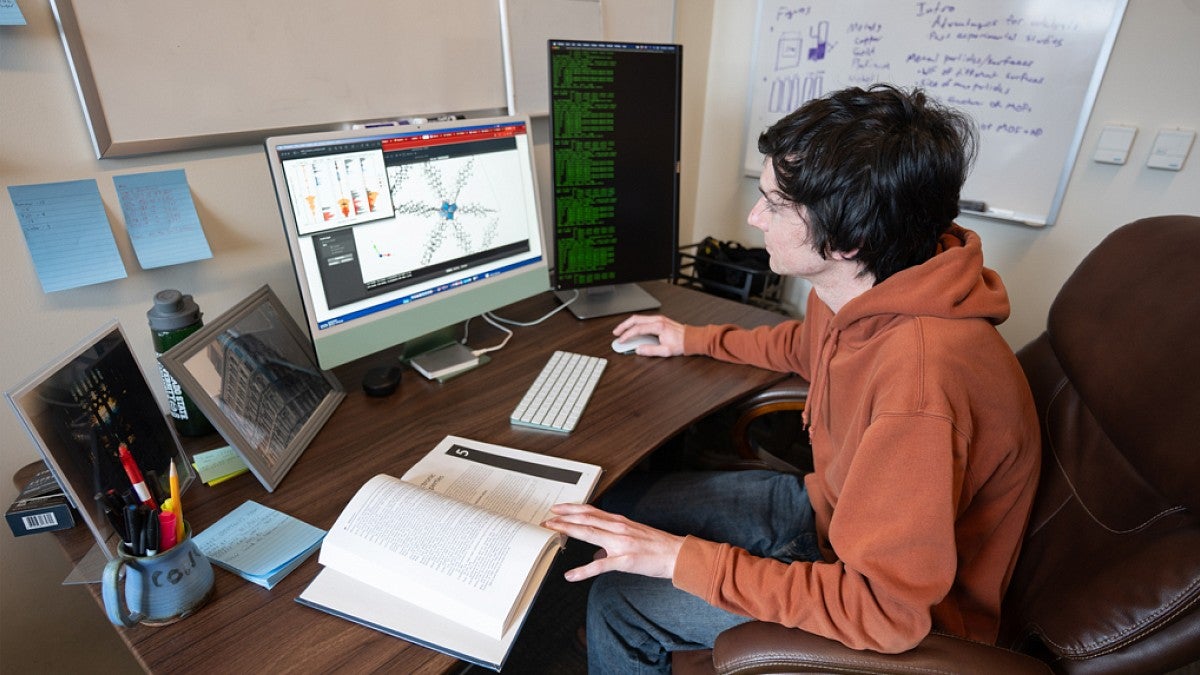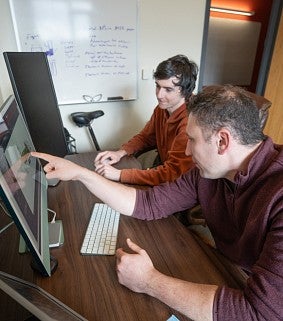
Experiential Learning | Research & Innovation | Community Impact | Career Preparation | Teaching Excellence | 21st Century Liberal Arts | Building Community | Good Vibes | CAS Spotlights | All Stories | Past Issues

February 28, 2024
A supercomputer scavenger hunt for energy storage
The discovery of a material that can efficiently store and deliver electrochemical energy could be a game changer in the transition to clean power.
Christopher Hendon and his chemistry research group are searching for it—not in the ground, but in the circuits of a supercomputer.
Using the University of Oregon’s high-performance computer cluster, Talapas, they’re mining data to pinpoint materials that have the right properties to help solve some of the world’s most pressing sustainability problems.
As a society, “we generate a lot of energy, but we also lose a lot of it,” says Hendon, an associate professor in the College of Arts and Sciences’ Department of Chemistry and Biochemistry. “When you open the door, heat goes out of your house. I want to find creative ways to catch that lost energy. The big picture in my research group is how can we capture and store the electrical charge in chemical bonds?”
The Hendon Lab focuses primarily on metal-organic frameworks, a broad class of crystalline materials that are extremely porous, offering large internal surface areas where electrochemical energy can potentially be stored, stabilized and discharged in a high-voltage burst.
“We’re looking for low-weight, novel electrical conductors for application in capacitive devices,” Hendon says. “We’re using high-performance computers to inform materialists whether target materials are useful or not.”
Unlike batteries, which deliver energy over a sustained period, capacitors deliver a high amount of voltage in a short time.

“When you’re driving an electric car and you put your foot on the accelerator, you want the immediate delivery of a high amount of electricity,” Hendon explains.
But the potential applications aren’t limited to Earth. In the frictionless environment of space, for example, only rapid bursts of energy are needed to move a spacecraft.
“These materials have a huge amount of promise for energy storage,” says Jasper Sterling, an undergraduate biochemistry major in Hendon’s lab. “There’s so much people are still learning about these metal-organic frameworks. The more we learn, the higher the chances that someone finds a material that has huge promise for sustainability.”
The lab's most recent research focuses on titanium-based clusters, whose photoactive properties could allow materials scientists to catalyze chemical reactions at room temperature by exposing them to light instead of using heat to propel their chemical processes.
"When light comes in, it excites some electrons in the materials, and those excited electrons can be used for some type of catalytic application,” says chemistry graduate student Brian Diamond.
Such a material could help lower the barrier to scientific experimentation, permitting scientists to perform more reactions in a shorter amount of time, Hendon says. It also has potential applications in pharmaceutical drug development as well as in efforts to reduce carbon dioxide down to a useful fuel such as ethanol or methanol, Diamond adds.
While materials chemists explore the properties of different materials by conducting physical experiments, Hendon and his group use computer modeling to compare materials and assess which are the likeliest candidates for further experimentation.
“There are some things we can learn from modeling these systems that you wouldn’t be able to see in an experiment,” Diamond says. “We can model the specific states that different electrons are in, and we can see where those electrons are sitting in the material, whether on the titanium atoms or elsewhere. This is not something you would be able to see experimentally because it’s on too small of a scale. We can also look at a large variety of different structures and electronic states all at once.”
Hendon’s team works closely with materials scientists at UO and beyond, identifying materials for experimentation and then using the results of those experiments to improve their models.
“This iterative process makes my research inherently collaborative,” Hendon says. “We’re trying to lead experiment, but we’re also being led by experiment.”
Whether or not Hendon’s team discovers the next game-changing material, their research is helping to guide other scientists who are also exploring the enormous potential of metal-organic frameworks.
“You don’t know what will be the breakthrough that gives rise to the next wonderful technology that helps reduce emissions or catch latent heat,” Hendon says. “To get to that point, you have to have an accumulation of basic scientific knowledge that allows smart people to take a seemingly illogical step forward to make a big breakthrough.”
